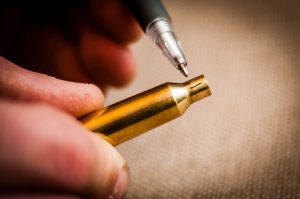It does not matter whether you are a professional, passionate shooter or an aspiring one taking baby steps to excel at it, if you are into shooting, you would probably acknowledge that reloading is almost therapeutic to the soul. And the fascination with manually reloading your ammunition is understandable, for no matter how long the process is being able to build your own ammunition definitely entails satisfaction. Plus, you get to save money, which is like a double treat!
Unfortunately, both beginners and experts are likely to make some very common reloading mistakes, which can, at times, turn out to be threatening. This article is all about educating you about mistakes you could possibly make and the ways in which they can be dodged.
So, shall we get started?
Reloading Mistakes at a Glance:
- Crack and dents on Cartridge Case
- Inaccurate Powder Charge
- Primer Seating
- Inaccurate Bullet Seating
- Too much or too little Crimping
- Too long Cartridge case
The 6 Most Common Reloading Mistakes
1. Crack and dents on Cartridge Case
Cartridge cases or shells are made of brass and you can readily tell a used case off the new ones. Since one of the reasons shooters go for reloading is the ability to minimize cost and there are, of course, chances that you are using a used cartridge case.
That being the case (No pun intended!), there is a fair chance of there being cracks in any part of the case. Cracks may hinder shooting precision as the gas escapes through them when you shoot, but in severe cases, it might as well cause an explosion, leaving you injured.
You can, fortunately, avoid such happenings by carefully inspecting the case before use. However, at times these cracks might not be very notable and in such cases, trying to feel for the cracks with fingers might help.
Dents in cases are also equally dangerous for these could lead to inaccuracy and, at worst, create involuntary firing. In the case of both a dent and a crack, we would suggest buying a new one in order to avoid serious accidents.
2. Inaccurate Powder Charge
When reloading, you are to load gunpowder, an explosive propellant in the cartridge. Most people make a mistake in either using the right powder charge for the right weapon or getting the ratio of powder right.
You will find a lot of different gunpowder in the market. You can either use a fast burning or a slow-burning powder, depending on the bullets’ size. Since there are lots of things to keep in mind, even professionals end up making mistakes. However, bear in mind that precision in measurement is exceptionally crucial, or there could be an explosion.
Beginner kits do come with a detailed manual and automatic measurement facility, which could ensure accuracy. You can choose from the best Reloading Kits for beginners in case you want to rely on the stated measurements. However, you can also weigh your bullets to figure out which kind and what measurement of reloading powder is needed.
3. Primer Seating
Primer, a tiny metal cup containing explosives and is placed in the middle of the cartridge’s base. One of the most common reloading mistakes involves seating them either way too deep inside or not deep enough, both of which can cause the primer to be sensitive upon impact, which can cause serious issues. Also, if you seat your primer way deep within, there is a chance of it cracking.
In order for the primer seating to be accurate, first things first, you need to have a visual idea about its accurate position. If you have trouble reaching the base of the cartridge, you might need certain small tools and fortunately, some presses might help in this situation
4. Inaccurate Bullet Seating
One more challenging task is to fit the projectile or the bullet in the right position. Bullets are usually seated right at the mouth of the case. Once again, if seated in inaccurate positions, the bullet might recoil and also not end up reaching the target. That’s pretty bad, right?
In order to avoid any problem arising from the wrong placement of bullets, you need to cross-check to make sure that they are about in the right position, and ready to use bullets might be a good way to tackle this problem too.
5. Too much or too little Crimping
Once you have placed the bullets in position, you would be expected to do something called crimping that is responsible for holding the bullets in position. However, too much or too little crimping is problematic and a common mistake made while reloading.
Too much crimping can cause the bullet to recoil while if it is too loose, the bullet might come off. Therefore, you need to settle for somewhere in between, making it too tight and too loose.
6. Too long Cartridge case
Even professionals will admit that trimming cartridge cases is quite a task. On the other hand, if you use the wrong case size, you might end up not reaching the target. Understanding which size to use is definitely challenging not only for the newbies but for the veterans alike.
While you might think that this is not a big issue, it certainly does affect the accuracy of shooting. The best way to avoid this is by trimming your cartridge case on a regular basis.
Final Words
They say that you learn from your mistakes, but we highly doubt if you would want to do the same in case of shooting, at the expense of your wellbeing. In no way are we trying to discourage you, reloading is definitely a rewarding process, but taking precautions should not hurt, right?
Remember, it is all about precision, and certain products might come in handy. You can find the Best Calipers For Reloading to help you with the process. There is no doubt that the higher the precision, the lesser are the chances of not being able to meet the target and of accidents, and therefore it is worth being patient throughout the process.
And now that you have known the Common Reloading Mistakes you can actually make, we do hope that this article comes across helpful, especially for those who just got into reloading.

